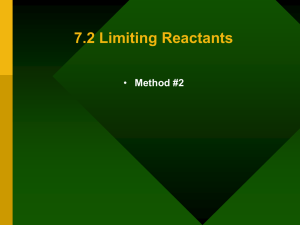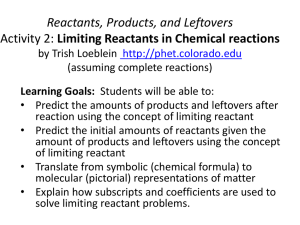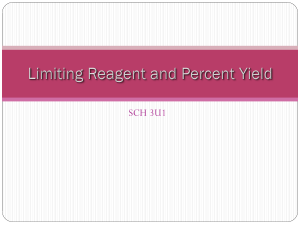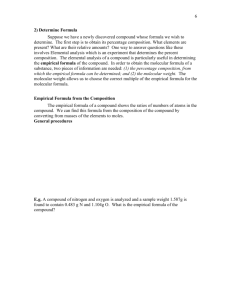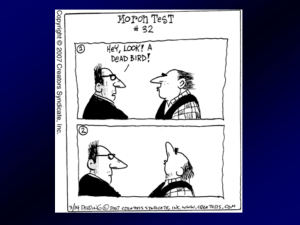Unit 7 - Stoichiometry
advertisement
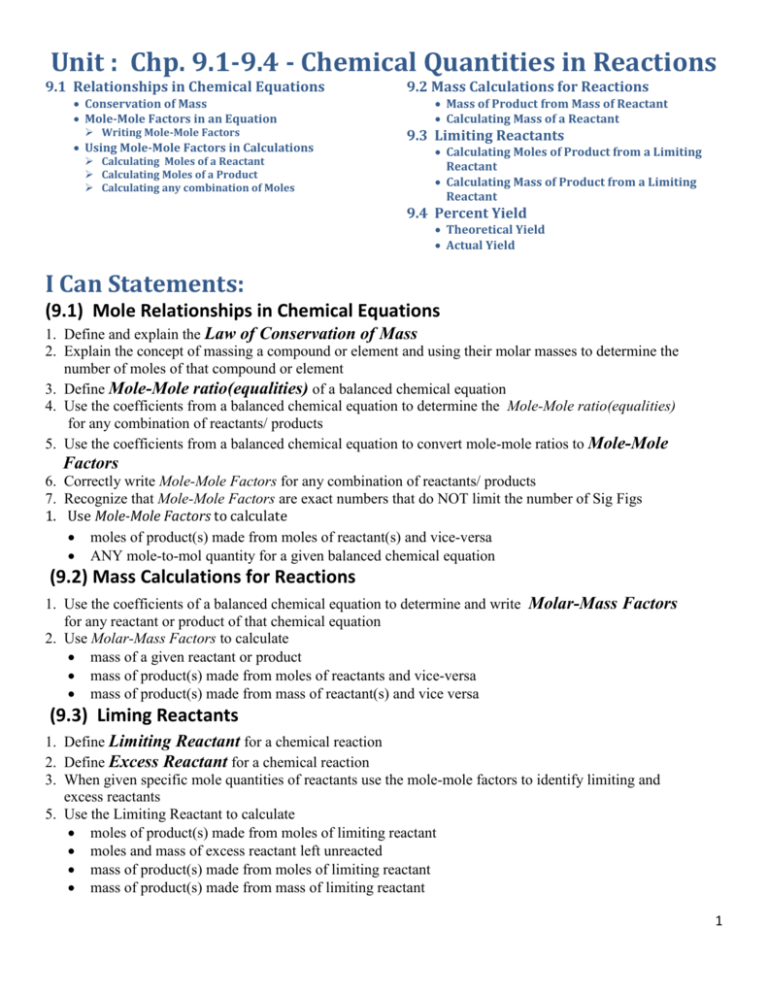
Unit : Chp. 9.1-9.4 - Chemical Quantities in Reactions 9.1 Relationships in Chemical Equations Conservation of Mass Mole-Mole Factors in an Equation Writing Mole-Mole Factors Using Mole-Mole Factors in Calculations Calculating Moles of a Reactant Calculating Moles of a Product Calculating any combination of Moles 9.2 Mass Calculations for Reactions Mass of Product from Mass of Reactant Calculating Mass of a Reactant 9.3 Limiting Reactants Calculating Moles of Product from a Limiting Reactant Calculating Mass of Product from a Limiting Reactant 9.4 Percent Yield Theoretical Yield Actual Yield I Can Statements: (9.1) Mole Relationships in Chemical Equations 1. Define and explain the Law of Conservation of Mass 2. Explain the concept of massing a compound or element and using their molar masses to determine the number of moles of that compound or element 3. Define Mole-Mole ratio(equalities) of a balanced chemical equation 4. Use the coefficients from a balanced chemical equation to determine the Mole-Mole ratio(equalities) for any combination of reactants/ products 5. Use the coefficients from a balanced chemical equation to convert mole-mole ratios to Mole-Mole Factors 6. Correctly write Mole-Mole Factors for any combination of reactants/ products 7. Recognize that Mole-Mole Factors are exact numbers that do NOT limit the number of Sig Figs 1. Use Mole-Mole Factors to calculate moles of product(s) made from moles of reactant(s) and vice-versa ANY mole-to-mol quantity for a given balanced chemical equation (9.2) Mass Calculations for Reactions 1. Use the coefficients of a balanced chemical equation to determine and write Molar-Mass Factors for any reactant or product of that chemical equation 2. Use Molar-Mass Factors to calculate mass of a given reactant or product mass of product(s) made from moles of reactants and vice-versa mass of product(s) made from mass of reactant(s) and vice versa (9.3) Liming Reactants 1. Define Limiting Reactant for a chemical reaction 2. Define Excess Reactant for a chemical reaction 3. When given specific mole quantities of reactants use the mole-mole factors to identify limiting and excess reactants 5. Use the Limiting Reactant to calculate moles of product(s) made from moles of limiting reactant moles and mass of excess reactant left unreacted mass of product(s) made from moles of limiting reactant mass of product(s) made from mass of limiting reactant 1 (9.4) Percent Yield 1. Define and calculate Theoretical, Actual, and Percent Yields for a chemical reaction Vocabulary 9.1 - 9.4 actual yield excess reactant law of conservation of mass limiting reactant molar-mass factor mole-mole factor mole-mole ratio percent yield theoretical yield Achievement Scale 9.1 - 9.4 Goal 9.1 Mole Relationship s in Chemical Equations 9.2 Mass Calculations for Reactions 9.3 Limiting Reactants 9.4 Percent Yield C Level B Level A Level Can use molar masses to determine if an equation obeys the Law of Conservation of Mass Can use the coefficients of a balanced chemical equation to identify or determine and write molemole ratios(equalities) Can state that mole-to-mole ratios are exact numbers and do not change the number of Sig Figs Can use mole-mole ratios (equalities) to write and/or identify correct mole-mole factors for a given chemical equation Can use mole-mole factors to calculate moles of product(s) made from moles of reactant(s) and vice-versa can use mole-mole factors to calculate ANY moleto-mole quantity (for example: moles of 2nd reactant needed to completely react moles of 1st reactant) Can write and/ or identify correct molar-mass can use molar-mass can use molar-mass factors for a given chemical equation factors to calculate factors to calculate mass of product(s) from mass of product(s) Can use molar-mass factors to calculate mass of moles of reactant(s) from mass of given moles of reactants or products and vice-versa reactants(s) and viceversa Can define both limiting reactant and excess can use moles of can use mass of reactant for a chemical reaction limiting reactant to limiting reactant to calculate mass of calculate mass of can use mole-mol factors to identify limiting and product(s) product(s) excess reactants for a given chemical equation can use moles of can use moles of limiting reactant to calculate limiting reactant to moles of excess reactant left unreacted calculate mass of can use moles of limiting reactant to calculate excess reactant left moles of product(s) unreacted Can define theoretical, actual, and percent yield can calculate a Can calculate a theoretical yield, in theoretical yield, in can, if given any two of the above quantities, grams, when given grams, when given calculate the third moles of reactant(s) mass of reactant(s) can calculate a theoretical yield, in moles, when given moles of reactant(s) 2 Sample Questions 9.1 - 9.4 C Level: 4Na(s) + O2(g) → 2Na2O(s) 1. Answer the following questions based on the balanced chemical equation shown above. (a) Used molar masses to prove that this reaction obeys the law of conservation of mass. 91.96 g Na, 32.00 g O2 → 123.96 g Na2O (b) What is the mole-mole ratio of Na2O to Na? 2 moles Na2O : 4 mole Na (c) Write a correct mole-mol factor for ratio of Na2O to Na or (c) Calculate the number of moles of sodium metal needed to make 3 moles of Na2O. (Assume there is excess O2 so that all of the Na will react.) 3 moles Na2O = 6 moles Na needed (d) Calculate the mass of 6 moles of Na2O. 6 moles Na2O = 371.9 g of Na2O (e) In the reaction of 5 moles of sodium with 2 moles of oxygen gas, which is the limiting reactant? 5 moles Na = 2.5 mol Na2O can be made LESS Na2O can be made with the Na so..... Na is limiting 2moles O2 = 4 moles Na2O can be made (f) For (e) calculate the moles of excess reactant left unreacted. i) 5 moles Na = 1.25 mol of O2 will be used ii) 2 mole O2 − 1.25 mole O2 = 0.75 mol of O2 left unreacted (g) For (e) calculate the moles of Na2O which can be made. already done! - see (e) = 2.5 moles of Na2O can be made (h) If the theoretical yield of Na2O was 2.5 mole and the actual yield was 2.0 mol, calculate the percent yield of Na2O. x 100 = 80 % yield 3 B Level: 4Na(s) + O2(g) → 2Na2O(s) 2. Answer the following questions based on the balanced chemical equation shown above. (a) Calculate the mass in grams of Na2O that can be made from 3.75 moles of O2. (Assume there is excess Na so that all of the O2 will react.) 3.75 moles O2 = 465 g Na2O (b) Calculate the mass in grams of Na2O that will be made if 1.0 mol of Na reacts with 0.75 mol of O2. 1.0 moles Na i) = 0.50 mol Na2O can be made LESS Na2O can be made with the Na so..... Na is limiting 0.75 moles O2 = 1.50 moles Na2O can be made ii) 1.0 moles Na = 31 g Na2O (c) Calculate the percent yield if the reaction in (b) was run and the actual yield of Na2O was only 22.6 g. x 100 = 73% yield A Level: 4Na(s) + O2(g) → 2Na2O(s) 3. Answer the following questions based on the balanced chemical equation shown above. (a) Calculate the mass in grams of Na2O that can be made from 35.0 g of O2. (Assume there is excess Na so that all of the O2 will react.) 35.0 g O2 = 136 g Na2O (b) Calculate the mass in grams of Na2O that will be made if 95.0 g of Na reacts with 35.0 g of O2. 95.0 g Na = 128 g Na2O LESS Na2O can be made with the Na so..... Na is limiting therefore, 128 g of Na2O will be made (c) Calculate the percent yield if the reaction in (b) was run and the actual yield of Na 2O was only 125g. x 100 = 98 % yield 4



